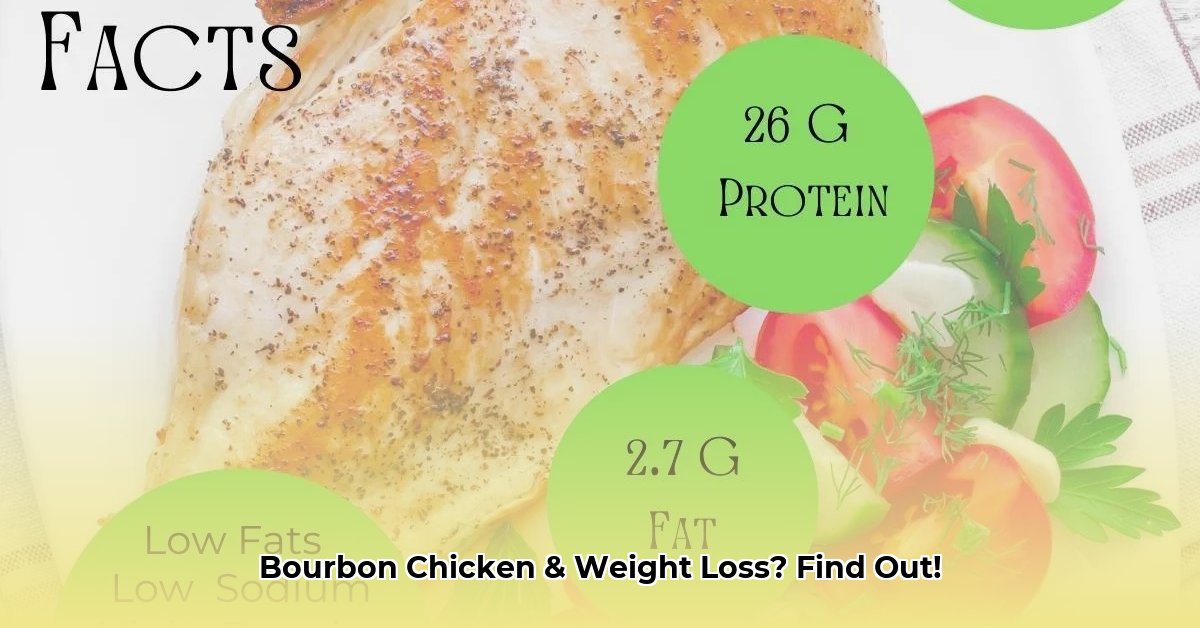
Understanding Bourbon Chicken and Weight Loss
Bourbon chicken, with its savory sauce and tender chicken, is a tempting dish. But can it fit into a weight-loss plan? The answer is nuanced. While it offers protein, crucial for satiety and muscle maintenance, the high sugar, sodium, and calorie content in the sauce present challenges. This guide provides actionable strategies to enjoy bourbon chicken mindfully without derailing your weight loss efforts. We'll explore the nutritional profile, offer recipe modifications, and provide tips for portion control, both at home and when dining out.
Deciphering the Nutritional Code
Bourbon chicken's nutritional value depends heavily on preparation methods and portion sizes. A typical restaurant serving (often fried) can pack 400-500 calories, with a significant portion stemming from fat and added sugar. Homemade baked versions can substantially lower this, often falling in the 250-350 calorie range. Protein content generally remains consistent, between 25-35 grams per serving, regardless of preparation. However, sodium and sugar levels vary dramatically, impacting overall health and weight management. Isn't it interesting how a seemingly simple dish holds such nutritional complexity?
Here's a comparison to illustrate the impact of preparation methods:
| Preparation Method | Calories (approx.) | Protein (g) (approx.) | Fat (g) (approx.) | Sodium (approx.) | Sugar (approx.) |
|---|---|---|---|---|---|
| Restaurant-Style Fried | 400-500 | 25-35 | 20-30 | Very High | Very High |
| Homemade Baked | 250-350 | 30-40 | 10-15 | Moderate | Moderate |
| Restaurant-Style Grilled | 300-400 | 30-35 | 15-20 | High | Moderate |
The Sauce: The Primary Culprit
The sauce is the primary driver of bourbon chicken's less-than-ideal nutritional profile. Restaurant sauces are often loaded with added sugars and excessive sodium. High sugar leads to blood sugar spikes and subsequent crashes, leaving you feeling hungry. Excessive sodium contributes to water retention, making you feel bloated. To make bourbon chicken weight-loss friendly, we must address the sauce.
Portion Control: Your Weight-Loss Weapon
Even the healthiest bourbon chicken can hinder weight loss if portions are excessive. Restaurant servings are often much larger than recommended portion sizes. This simple fact is often overlooked. Mastering portion control is crucial.
Making Bourbon Chicken Weight-Loss Friendly: A Practical Guide
Here's a step-by-step guide to making bourbon chicken a part of your weight-loss journey:
Embrace Homemade: Making bourbon chicken at home provides control over ingredients and cooking methods. You can select leaner cuts of chicken and create a healthier sauce.
Healthier Sauce Recipe: Reduce the sugar and sodium content by using less sugar (or a sugar substitute like stevia), low-sodium soy sauce, and natural flavor enhancers like ginger, garlic, or citrus.
Cooking Method Matters: Baking or grilling is healthier than frying. Frying adds unnecessary fat and calories.
Smart Ingredient Swaps: Replace refined sugars with natural sweeteners (in moderation). Opt for low-sodium soy sauce.
Add Vegetables: Boost the nutritional value and fiber content by incorporating vegetables into your dish. This will aid in satiety.
Strategic Integration: Plan bourbon chicken as part of a balanced weekly meal plan. Don't make it a daily occurrence.
Restaurant Strategies: Order smaller portions, request sauce on the side, choose grilled options, and consider sharing an entrée.
Conclusion: Enjoying Bourbon Chicken Mindfully
Bourbon chicken can be part of a healthy weight-loss plan with smart modifications. By focusing on portion control, healthier sauce choices, and balanced meal planning, you can enjoy this delicious dish without derailing your progress. Remember that consistent mindful eating habits and a balanced diet are key to sustainable weight loss. Consult a registered dietitian or your doctor for personalized advice.